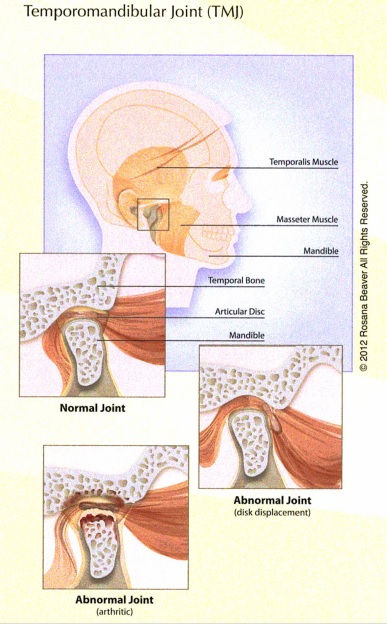TMJ Disorders Result from Overuse and Misalignment of Jaw Joint
TMJ Disorders can be the cause of facial pain, hearing loss, sinus congestion, neck pain, vertigo, and problems with the tongue.
 The temporomandibular joint, or TMJ, is the joint that allows the jaw to move. It joins together the lower jaw and the temporal bone on the skull. The most common cause of TMJ disorders is teeth grinding or clenching, which puts repetitive wear on the cartilage and connective tissues surrounding the joint, leading to headaches, jaw pain, facial pain and more.
The temporomandibular joint, or TMJ, is the joint that allows the jaw to move. It joins together the lower jaw and the temporal bone on the skull. The most common cause of TMJ disorders is teeth grinding or clenching, which puts repetitive wear on the cartilage and connective tissues surrounding the joint, leading to headaches, jaw pain, facial pain and more.
More than 10 million Americans are affected by TMJ disorders, which include a number of acute and chronic problems related to the areas of the head, jaw, face and neck. The people who live with TMJ disorders have their quality of life impacted as they deal with excruciating pain in the face, head and neck, along with other symptoms.
Physical Symptoms of TMJ Disorders
Ear Pain and Hearing Loss
TMJ Disorders can result in ear pain, stuffiness, tinnitus and hearing loss. This is due to the fact that the same nerves supply both the chewing muscles and the middle ear muscles. By adjusting the position of the jaw and the teeth with an orthotic splint, the root cause of the TMJ Disorder will be addressed and the symptoms will subside. The splint allows the muscles to rest and the TMJ joint to heal itself.
Swallowing Difficulty, Eating or Object in Throat
Given the fact that TMJ Disorders can impact a person's ability to chew, it can make it difficult to swallow or eat. In some cases, patients often have to deal with an object lodged in the throat. Orthotic treatment and physical therapy can be used in order to treat the TMJ Disorder and make it more enjoyable for the patient to eat again.
Sinus Pain and Congestion
Sinus pain and sinus congestion are not uncommon when a person is suffering from a TMJ disorder. The improper function of the jaw results in sinus pain near the cheek and eyes. In particular, patients who are missing teeth in the back of their mouth will experience these symptoms. In many cases, a dental splint can be used in order to realign the proper position of the teeth. Specialty splints can be created for those who have dentures.
Rheumatoid Arthritis
People who suffer from rheumatoid arthritis are at a higher risk of developing TMJ. Some studies show that up to ninety percent of people with rheumatoid arthritis also are afflicted with a TMJ Disorder. A customized treatment plan involving physical therapy and orthotic treatment can be created for those who have a TMJ Disorder as a result of rheumatoid arthritis.
Neck Pain and Neck Problems
The TMJ joint impacts muscles throughout the face and neck. Some people who have TMJ experience chronic neck pain and neck stiffness. Orthotic treatment that realigns the jaw and places teeth in the proper position can help alleviate neck pain associated with TMJ.
Vertigo and Dizziness
Vertigo and dizziness are other symptoms that many people who have a TMJ Disorder experience. These can be frustrating symptoms that impact a person's ability to go about their daily life. As the TMJ joint impacts muscle movement in the neck and face, it's important to be sure that the jaw is properly aligned. Orthotic treatment, such as a dental splint, can properly align the teeth and allow the joint to heal. In addition, physical therapy can help minimize these symptoms.
Tongue Problems, Uncontrolled Tongue Movement or Tongue Burning Sensation
The TMJ joint can disrupt the nerves that supply the chewing muscles, which can result in tongue pain or restricted tongue movement. Dental splints can help to realign the jaw and place the teeth in the proper position, which improves the nerve supply to the muscles.
Are you experiencing one or more of these symptoms? Consider treatment for your TMJ Disorder.
